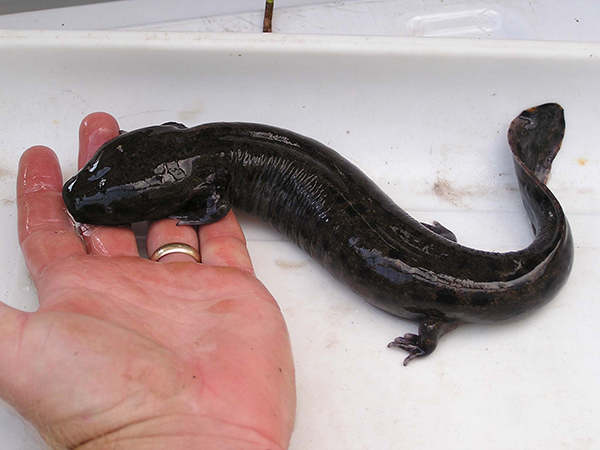By Louie Stout
 Creepy Mudpuppies are Kinda Cool - Indiana DNR Photo
Creepy Mudpuppies are Kinda Cool - Indiana DNR Photo
Creepy Mudpuppies are Kinda Cool - Indiana DNR Photo
During a recent conversation with Indiana District Fish Biologist Tom Bacula, he mentioned encountering “mudpuppies” during a fish survey on Maxinkuckee Lake.
“We don’t see many on other lakes, but find them often when we’re on Maxinkuckee,” Bacula said. “They like nice clean water.”
Mudpuppies are members of the salamander family and can be found in lakes, rivers and ponds. Most are rusty brown or have a gray and black back and grow to a little over 13 inches.
They have little legs and “feet” that allows them to craw on the bottom, and can look a little like newborn dog puppies. They have small mouths and bushy gills on the side of the head. While some salamanders survive on land, these do not.
My conversation with Bacula took me back to my younger days of growing up in Kokomo, a central Indiana city that you’ll pass through or around when traveling U.S. 31 to Indianapolis.
Before the “new bypass” was built that now takes you farther east of town, you drove over a Wildcat Creek Bridge on 31 under which I spent many childhood days and evenings fishing from the bank.
We’d pack a few snacks, dig a can of worms, and ride our bicycles to that location. We often fished there throughout the night.
We fished for catfish, hoped for a big bass, and mostly caught carp.
But we also caught quite a few mudpuppies. The mudpuppies were an unpleasant sight within the glow of our campfire. We found them creepy.
But they really aren’t. They’re just one of the many amazing creatures that live harmlessly among the aquatic world.
It’s been years since I’ve seen or heard of one being caught, so I contacted Nate Engbrecht, Indiana’s herpetologist, to find out more about these unique creatures.
Engbrecht, who grew up in Bremen, is equally fascinated with the critter, but admits information on their existence is limited.
“We don’t have much info about the population but we’d sure like to know where they do exist now,” says Engbrecht. “A lot of the reports we get come from fishermen who hook them unintentionally.”
He said mudpuppies most likely exist in some natural lakes and rivers and likely exist in the Kankakee, Elkhart and St. Joseph rivers, but he’s not had confirmation on that in recent years.
Mudpuppies are listed as a “special concern” in Indiana because it is believed their population is declining. Engbrecht said he gets a smattering of reports from biologists who encounter them during surveys but would like to hear from other Hoosiers who have encountered them from time to time.
“There are several different species of salamander in Indiana,” he said. Some people think they are hellbenders, but they aren’t and the hellbender is even rarer.”
Mudpuppies eat crayfish, minnows, insects and some fish eggs. They mate in autumn and deposit the eggs against solid objects in shallow water the following spring. Hatching occurs one to two months after they’ve been deposited and young mudpuppies mature in five or six years. They can live up to 20 years.
If you come across one, snap a picture and send it to Engbrecht at HerpSurveys@dnr.IN.gov.
Include the date you found it, body of water, and a geographical reference point as to where in the water you found it. It will help him learn more about the distribution.


